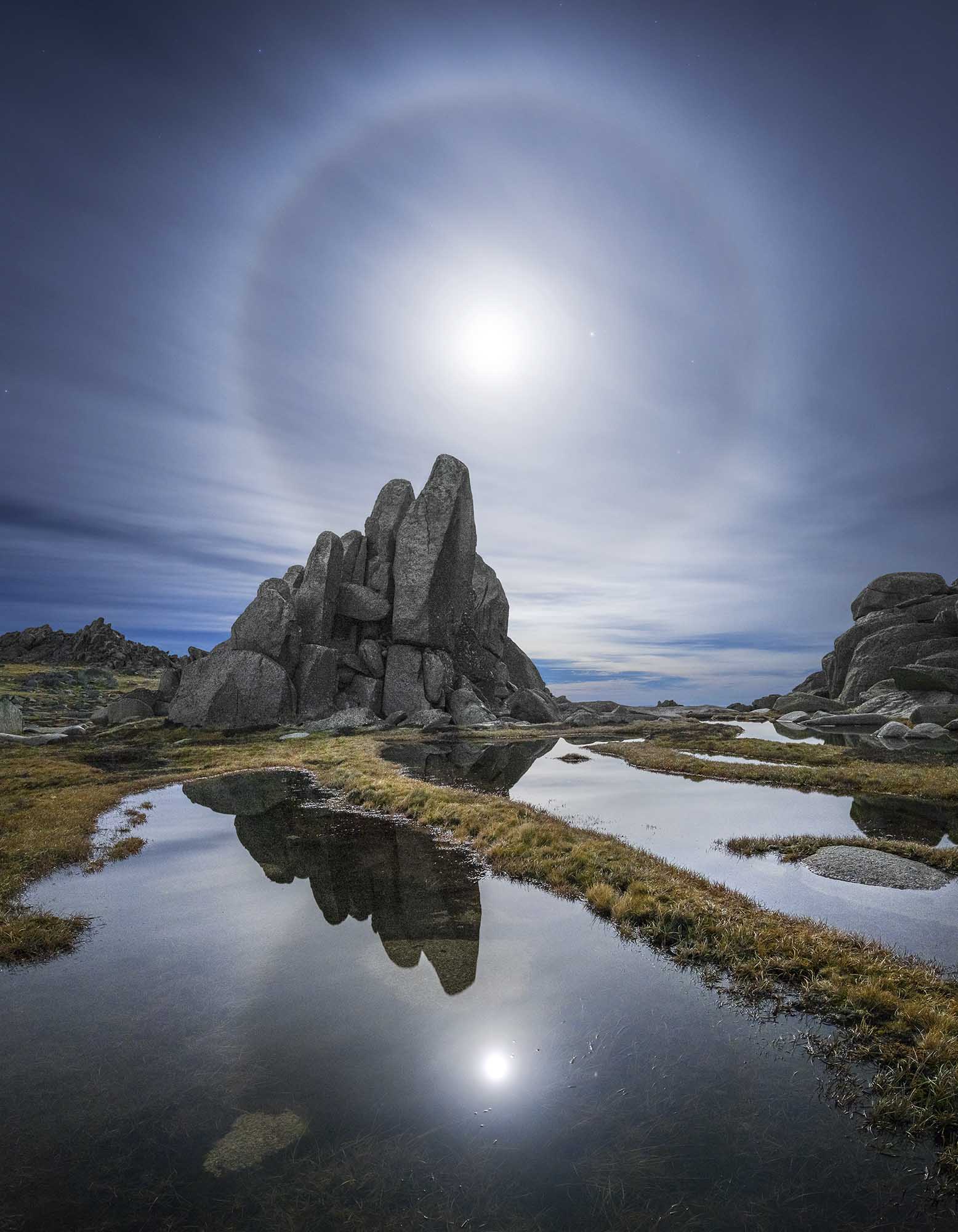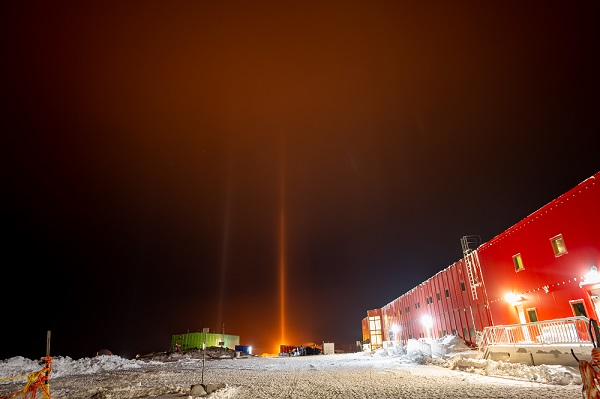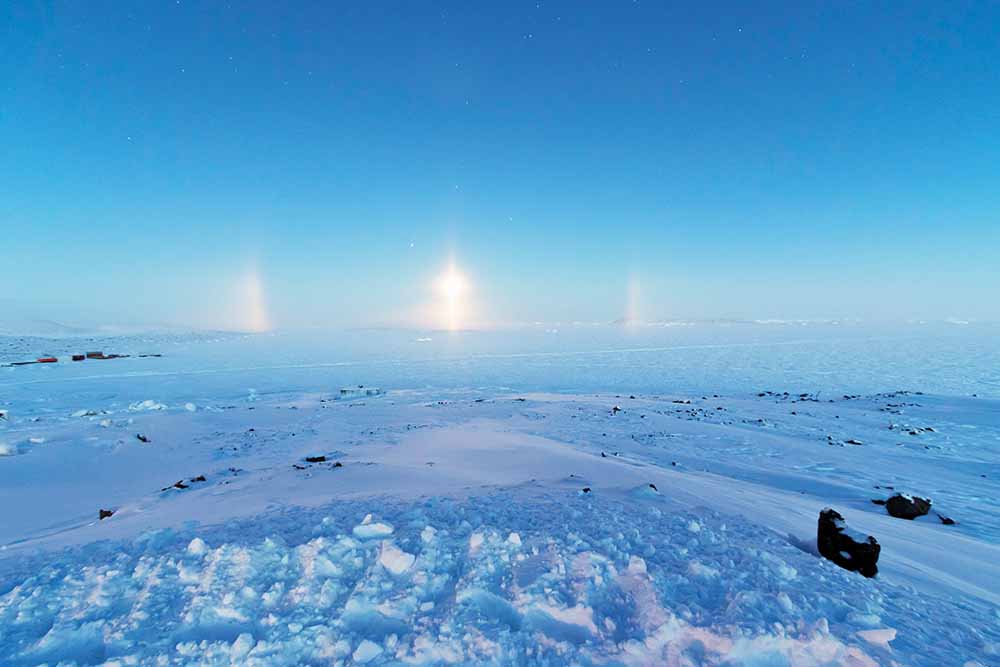Explainer: what are halos?
22 November 2018
Have you ever seen a ghostly ring around the moon? Dazzling bright spots or luminous pillars alongside the sun? Seen only when conditions are just right, halos inspire wonder and curiosity. So what causes this heavenly spectacle and what are the different kinds of halos and related phenomena you might spot?
Halos are a group of optical phenomena in the form of arcs, rings, pillars or bright spots. They're produced by the bending or reflecting of sunlight or moonlight by ice crystals in the atmosphere.

Image: Moon halo, Kosciuszko National Park, May 2016. Credit: Luke Tscharke
Why do we see halos?
Ice has a hexagonal molecular structure which results in ice crystals forming hexagonal prisms—a mixture of long columns and thin plates—the faces of which are all inclined at a 60° angle. This angle, plus the way the ice crystals align as they fall, creates the various types of halos.
While its uncommon to see complete rings or arcs, portions of them may be seen in parts of clouds comprised of ice crystals.
You’re more likely to see colours in a sun halo than one with the moon as a light source, which generally appears to be white.
What are the ideal conditions for seeing halos?
In Australia, you’re most likely to see halos when the sky is covered by a veil of high cloud (the cirrus cloud family). This is because temperatures high in the atmosphere where cirrus clouds form are so cold that the clouds are made of ice crystals.
How to view sun halos safely
When viewing sun halos, don’t forget there’s only one rule for looking directly at the sun—don’t do it! Always shield both eyes from it. Never stare directly at the sun, even for a moment. Instead, hide it behind the edge of a building or post—or use your hand to block it. Take care when photographing halos if the unshielded sun is in the field of view. It’s dangerous to look at the sun through some camera viewfinders, especially SLRs. None of this safety advice applies in the case of moon halos though—you can gaze at those to your heart’s content.
Types of halo
22° halo
The 22° or small halo is the most commonly seen halo with the light source (sun or moon) at the centre. The sky inside the halo is often darker than the sky outside it. As the light passes through the ice crystals its path is refracted (or bent) by 22–50°. No light is refracted at less than 22°. As a result the observer sees a halo around the sun or moon (shown below). When the sun is the light source, it shows a red fringe on the inside and in rare cases a violet fringe on the outside. This is because red light is refracted less than light of other colours.
-crop.jpg)
In Australia, the 22° halo is commonly associated with high cirrus cloud. Frequently only parts of the halo are visible as the cloud is either too thin or too thick for it to be fully visible.
To identify a 22° halo, hold your hand flat at arm's length with your thumb covering the sun. A 22° halo will be near the tip of your little finger.
Parhelic circle and sun/moon dogs
The parhelic circle is a white horizontal circle at the same elevation as the sun—it passes through the sun. In the case of the moon being the light source, it is known as a paraselenic circle. This halo type is formed by plate-shaped ice crystals.
Bright spots can occur along both parhelic and paraselenic circles. Most commonly, just beyond the 22°degree point, brilliantly coloured spots called parhelia/paraselenae can be seen.
Less frequently, further bright spots can be visible at 120° from the light source (called paranthelia/parantiselenae) and very rarely bright spots can be visible opposite the sun/moon (anthelion/antiselene).
In the case of the sun, bright spots are also known as mock suns or sun dogs and in the case of the moon—you guessed it—mock moons or moon dogs.

A sky full of atmospheric optics—22° halo, parhelic circle, sun dogs and an upper tangent arc, Sydney, 30 August 2018. Credit: Wathanyoo Prathumrat
Light pillar
A white, luminous pillar either continuous or broken, above or below a light source is known as a light pillar. When the sun is the light source this is known as a sun pillar. Pillars can form above and below the light source and are known as upper or lower pillars.
Occasionally light pillars can be seen above ground-based light sources (such as city lights and street lights)—this can only happen at temperatures cold enough for ground-level ice crystals. On rare occasions small pillars can be seen above or below a bright planet, such as Venus. Light pillars result from plate-shaped ice crystals producing a 'glint' as their flat-faced side bounces light directly to your location.

Image: Light pillars at Casey Research Station, Antarctica. Credit: Barry Becker
Tangent arc
This is a catch-all term for any arc forming 'tangentially' to other halos. Tangent arcs are most frequently seen on the outside of the 22° halo at its upper or lower extent. At times the arc may not be fully visible and simply appear as a brightening at the upper, lower or both portions of the 22° halo.
The tangent arc's shape is dependent on the elevation of the light source (sun or moon). When the light source is low to the horizon the tangent arc may be a sharp ‘v’ shape. If the light source is higher above the horizon the ‘v’-shape may look like the wings of a bird. When the light source is around 32° elevation or higher, the tangent arc can invert, eventually becoming circular and merging with the 22° arc.
Circumzenithal arc
Only visible when the sun is 32° or lower, the circumzenithal arc is a near-zenith colourful half circle with its highest point about 48° above the sun. Blue is visible at the top of the arc, red at the bottom. Like parhelic circles, circumzenithal arcs form from plate-like ice crystals: In this case, light enters the thin edge of the plate and exits the flat top. If you see parhelia (sun or moon dogs), look higher—about two hand spans above the light source—as you may also spot a circumzenithal arc.
Circumhorizon arc
Only occurring when the sun (or moon) is higher than 58° elevation, this halo arc is very colourful, about two hand spans below the light source and is aligned around parallel to the horizon. Forming around 10 times less frequently than the common 22° halo, this arc is again formed by plate shaped ice crystals high in the atmosphere. Light enters the thin edge of the plate and exits the bottom, flat part of the plate. With light rays passing a 90° face, this arc consists of very bright, well separated prismatic colours, ever purer than a rainbow! Red is visible at the top, blue at the bottom.
Diamond dust
All halos result from the refraction (bending) or reflection of light as it passes through ice crystals. In the temperate climate of Australia these ice crystals are typically only found high in the atmosphere. Since the ice crystals are so distant, we tend to only see partial halos, the 22° halo being the exception.
However, in very cold temperatures, typically less than –10° C, when the weather is just right (clear and calm) ice crystals can spontaneously form and slowly fall at ground level. This is known as diamond dust. Under these conditions complete halos can be common and often multiple halo types can be seen together, including rare ones. These weather conditions are usually only found in alpine, polar or other very cold regions.

Image: Diamond dust, partial 22° halo and light pillar over Prydz Bay, Davis Research Station, Antarctica. Credit: Aaron Stanley, APS Photography
More information
This article covers just some of the more commonly seen halo types. For more information on these and other halos check out these websites:
- Atmospheric optics
- Halo phenomena (WMO International Cloud Atlas)



Comment. Tell us what you think of this article.
Share. Tell others.